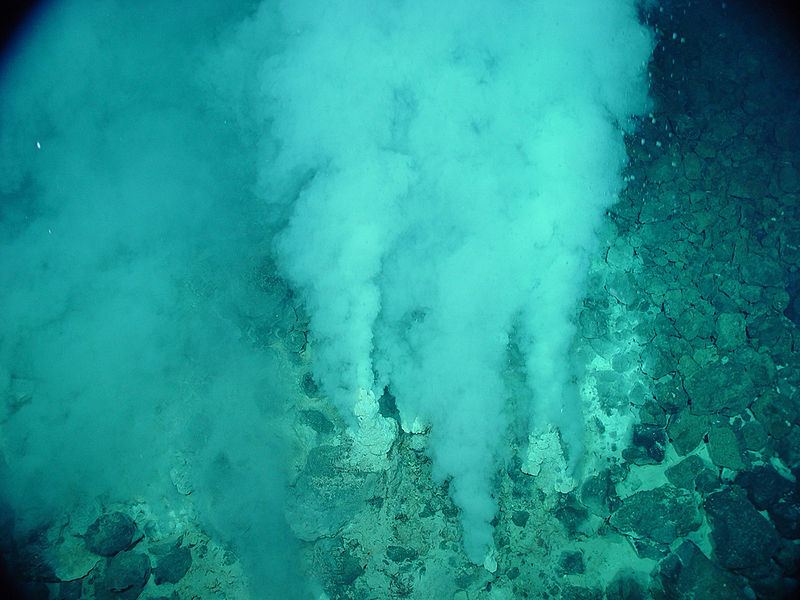Scientists recreated ancient Earth's ocean hell to figure out how life began
The experiment also suggests that extraterrestrial life could also emerge on Mars, Europa, and Enceladus
One theory for how life emerged suggests that it originated in the sea, at alkaline hydrothermal vents. It's impossible to observe life-in-the-making in hydrothermal vents nowadays, though, as the seabed has drastically changed in the billions of years since. Instead, researchers at NASA’s Jet Propulsion Laboratory have recreated early Earth’s deep-sea conditions in their lab to experimentally verify this theory.
A team of scientists, led by Lauren White, has built a reactor that mimics early Earth’s geological processes at the bottom of the ocean. By mixing CO2 and hydrogen-rich fluids — proxies for early Earth’s acidic ocean waters and alkaline hydrothermal spew — across a reconstruction of an ancient seafloor, the reactor successfully converted CO2 into simple organic molecules.
The conversion pathway of CO2 to organic molecules has long confounded scientists. All building blocks of life, from amino acids to DNA strands to sugars, contain carbon. But in Earth’s early years, carbon was mostly locked in the atmosphere as carbon dioxide.
Hadean Earth then was — like its name suggests — hellish: asteroids pelted the Earth and volcanoes constantly erupted. CO2 levels in the atmosphere were more than a thousand times today’s amount, and much of it dissolved into the oceans, turning the water acidic.
As the terrestrial world raged above, the ocean floor was also churning. Fresh rock was delivered from deep within Earth’s mantle to the crust above it as if by a geological conveyor belt. The pristine rock readily reacted with seawater to produce hydrogen and the mineral serpentine in a reaction known as serpentinization. This hydrogen, under the coaxing of iron-rich metals in the seafloor and hydrothermal vents, converted dissolved CO2 into the simplest organic molecules. In the long march towards a biotic world, Earth had taken its first — and hardest — step.
What were these first organic molecules? The simplest way to find out would be by checking out current-day hydrothermal vents, such as the Lost City hydrothermal field at the bottom of the Atlantic Ocean. But it's not that simple. Aside from the vastly different atmosphere and rock compositions, today’s seafloor is also home to modern life such as bacteria, which belch out their own molecules. Instead, White and her team at JPL had to build their own reactor, the first experimental attempt to capture all the key conditions in early Earth’s seafloor. This reactor accommodates hydrostatic pressures of 100 bar (100 times atmospheric pressure) and temperatures above 100 degrees Celsius.

A team of scientists built a reactor to simulate conditions around deep-sea hydrothermal vents
This reactor was first designed in 2003 by White’s then-graduate advisor Michael Russell, an early proponent of the hydrothermal vent theory and the lead scientist of this study. According to Russell, the team used leftover parts from the Planck space observatory, a European Space Agency mission that observes cosmic microwave radiation, to assemble the reactor. After safety inspections (the reactor was to operate at high pressures and temperatures, and hydrogen is potentially explosive), the authors’ busy schedules (White is also involved in the Mars Perseverance rover mission which will launch this summer), and a California brush fire that came within 100 feet of the research buildings, forcing the reactor to be shut down, the scientists began their first experiments in 2007. They finished their project more than a decade later, in 2019.
The researchers measured irrefutable quantities of formate, the simplest organic molecule obtainable from CO2. Methane was also observed but only sporadically. Currently, there is some ambivalence on where the methane comes from. The researchers in this study think that it could be leaching from the minerals in the reactor. Nick Lane, a professor of evolutionary biochemistry at University College London who was not involved in the study, thinks that the methane may come from the hydrogenation of CO2 itself.
“If so, then serpentinization really does form methane directly,” says Lane. But he is surprised that the researchers aren’t seeing much else, such as more complicated organic molecules. It's possible the pressure and temperature conditions aren’t at the levels that the reactor would need to pump out those more complex products. Or it might be there are other necessary factors – perhaps during Hadean Earth, the pH gradients within the vents themselves were the main drivers of organic matter production instead of serpentinization in the seafloor.
“This is a proof of principle that organics really do form by serpentinization, but it’s a thin soup on offer – much more had to happen in the vents themselves,” says Lane.
These simple organic molecules are a far cry from the complex bio-molecules in our bodies today, but it’s a promising start. More importantly, the results demonstrate that these initial chemical reactions are possible under the harsh conditions of a high temperature, high pressure deep-sea environment on a hellish world.
"We are still a long way from demonstrating that life could have formed in these environments,” said White in a NASA press release. “But if anyone ever wants to make that case, I think we'll need to have demonstrated the feasibility of every step of the process; we can't take anything for granted."
Russell echoes this sentiment. Life on Earth seems miraculous and complicated enough; studying how life emerged billions of years ago from an abiotic landscape is extremely difficult.
“It’s really hard. It’s the biggest question,” says Russell.

Europa, with an ocean buried under kilometers of ice, is thought to have geology conducive to life
If life was kickstarted by Earth’s geological processes, that means life in general may not be a freak accident but perhaps an inevitable outcome, especially on worlds with a similar geology. Mars, Europa, and Enceladus are promising candidates for extraterrestrial life — extinct or not — because they may have (or had) one thing in common: serpentinization occurring where liquid water meets rock.
Mars’ atmosphere contains methane, for which scientists speculate that serpentinization is the culprit. The ocean on Jupiter’s moon Europa is buried underneath kilometers-thick ice; scientists have found signs of oceanic geology at play in the form of salt crisscrossing Europa’s icy surface. Hydrothermal activity is most strongly suspected on Enceladus, one of Saturn’s 82 known moons. In 2017, the Cassini probe discovered hydrogen gas in the plumes erupting from Enceladus’ subsurface ocean, suggesting that the ocean is out of chemical equilibrium and hence fertile for life.
Space agencies are planning to send spacecrafts to hunt for biosignatures on those worlds, but their efforts will take several years. For now, lab-built reactors will have to do to satisfy our curiosity about the origin of life, and one of them is already raising new questions faster than we can answer them.






Really interesting article. I’m incredibly impressed with the determination of the scientists behind the research considering all the obstacles they encountered! I’ve always found the sea floor quite fascinating, and it’s intriguing to think about it as the potential origin of life on Earth. Is there any word on how this research will continue while we wait for spacecrafts to arrive on other worlds?